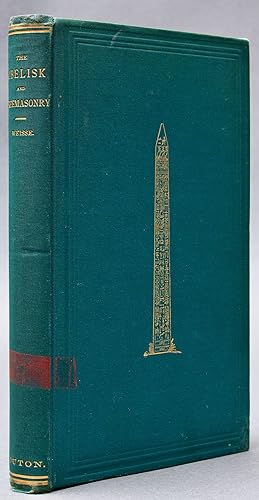About this Item
First Edition of this consideration claiming correspondences between ancient Egyptian obelisks and Freemasonry, shedding light on the beginnings of civilization. Demy 8vo (231 x 141mm): [2],178,34pp, with tissue-guarded frontispiece, six additional full-page plates of the Central Park obelisk, its construction, and symbols (three in color), and numerous line drawings. Publisher's blue-green cloth, front cover paneled in blind with gilt obelisk device, spine ruled and lettered in gilt, leaf-patterned end papers. Ex libris to front paste-down of freemasonry Lodge "Mark Masons Hall" and of Masonic member Wolfram Kraffert. Faint red band, an ancient Egyptian symbol of regeneration and of Freemasonry, to lower spine. A beautifully preserved example, tightly bound and clean throughout. Weisse was a French-American physician, philologist, and archaeologist with interests in both Freemasonry and ancient Egypt. The focus of his treatise is the connection between Freemasonry and Henry Honeychurch Gorringe's discovery of Masonic emblems and symbols on the obelisk known as Cleopatra's Needle, which, at the time of this writing, was in the hold of the steamship S.S. Dessoug on its way to New York. Gorringe and Giovanni Battista Belzoni, an Italian adventurer and sometime archaeologist, believed that secret societies akin to Freemasonry predated construction of obelisks and pyramids in ancient Egypt, as evidenced by the carvings on Cleopatra's Needle of Masonic tools (square, compass, plummet, and the like) that would have been necessary to construct those architectural wonders. Cleopatra's Needle was created during the reign of the 18th Dynasty Pharaoh Thutmose III. During the nineteenth century, Egyptomania swept through British and American cities, which scrambled to acquire obelisks to erect in their parks and squares. Cleopatra's Needle (whose creation is not actually connected with the Ptolemaic Queen Cleopatra VII, but legend has it that she brought a similar obelisk, now in London, from Heliopolis to Alexandria to decorate a new temple), was erected (and still stands) in Central Park, in 1881. Gorringe supervised transport of the 200-ton red granite monument from Alexandria to Greywacke Knoll, in Central Park, just across the drive from the Metropolitan Museum of Art. N. B. With few exceptions (always identified), we only stock books in exceptional condition, carefully preserved in archival, removable mylar sleeves. All orders are packaged with care and posted promptly. Satisfaction guaranteed. (Fine Editions Ltd is a member of the Independent Online Booksellers Association, and we subscribe to its codes of ethics.). Seller Inventory # BB2554
Contact seller
Report this item
![]()




